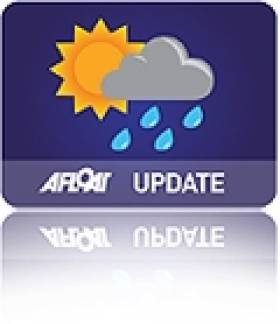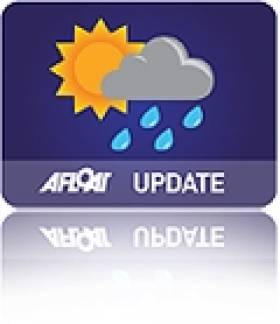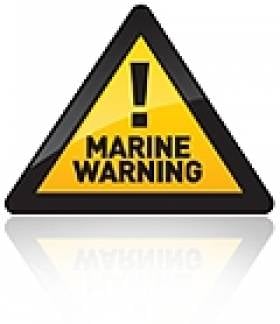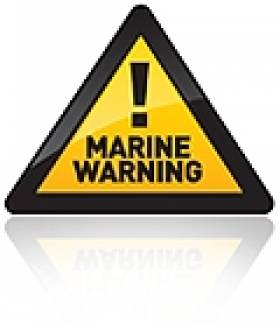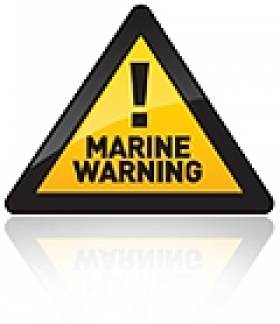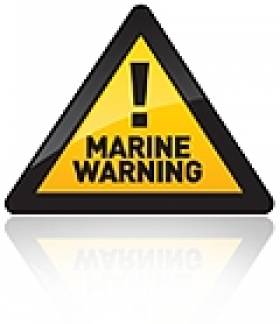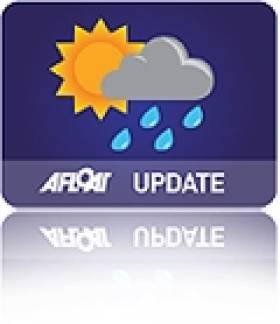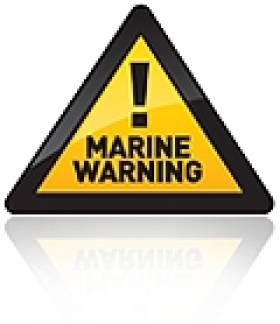Displaying items by tag: marine warning
Flood Alerts In Galway And Cork As Stormy Weather Returns
#Weather - RTÉ News says flood alerts have been issued for Galway and Cork as more stormy weather sweeps in from the Atlantic this evening (2 January).
Western and southern areas will be worst affected, with Met Éireann declaring Status Orange for Donegal, Clare, Connacht, Limerick, Kerry and Cork.
Wind speeds in these areas this evening and tonight may reach 90km/hr with gusts of up to 130km/hr along with heavy rain, high tides and high seas, which presents a flooding risk in coastal areas that may remain till this Sunday 5 January.
Cavan, Monaghan, Tipperary, Waterford and Leinster counties should expect winds of up to 80km/hr with 110km/hr gusts with similar coastal flooding risks.
Meanwhile, Met Éireann has declared a Status Orange marine warning for south to south-east gales expected to develop later today on all Irish coastal eaters and on the Irish Sea.
These winds will range from gale to storm force in all sea areas tonight, with "violent storm force" winds on the north-west coast.
Coastal and waterside areas throughout the UK are also on alert for this new wave of "exceptional weather", especially in Devon and Cornwall where waves were reaching nine metres in some spots this afternoon.
Shipping Forecast Could Be Affected By Transmitter Shutdown Next Year
#MarineWarning - Practical Boat Owner gives plenty of prior warning on plans by the BBC to shut down its Droitwich transmitter for maintenance next year, which could affect the Shipping Forecast for the Irish Sea.
The 12:01 shipping forecast "will potentially be transmitted at a lower power or ma be in audible on LW" for the period from April to August 2014 as Droitwich undergoes essential maintenance.
PBO has more on the story HERE.
Met Éireann Warns Of Storm Force Winds Around Coast
#Weather - Met Éireann has issued a weather warning for tonight (Saturday 22 December) with winds expected to reach up to 110km an hour.
Tonight and tomorrow morning, south-west to west winds are likely to increase in most parts of the country, with mean speeds and gusts that "have the potential to be damaging".
The Irish weather service also reports strong gales on all Irish coastal waters and on the Irish Sea, with winds expected to reach storm force later on coasts from Valentia to Erris Head to Fair Head.
Marine Notice: Works on Quay Wall at North Wall Quay
#MARINE NOTICE - The latest Marine Notice (No 61 of 2012) from the Department of Transport, Tourism and Sport (DTTAS) advises that J Murphy & Sons, on behalf of Dublin City Council, will construct a 600mm emergency overflow pipe from Spencer Dock Pump Station through the Liffey quay wall at North Wall Quay/New Wapping Street Junction, Dublin 1.
The work will commence on or around 23 November 2012 and will last approximately two weeks, weather permitting. The location of the works relating to maritime positions is:
Latitude 53° 20’ 49.431 N / Longitude 006° 14’ 08.171 W
The works area will be marked by red buoys. These buoys will be an appropriate distance from the works area and will clearly identify the scaffold when submerged due to high tide. The cantilever beams will project 1.5 metres out from the quay wall.
The only vessel used during the works will be a rescue boat which will be moored at the works location for its duration.
Marine Notice: Cable Laying in Irish Sea Between Wales and Portmarnock
#MARINE WARNING - The latest Marine Notice from the Department of Transport, Tourism and Sport (DTTAS) advises mariners of cable laying operations in the Irish Sea from next week onwards.
The cable laying operations between Wales and Portmarnock Beach in north Co Dublin will commence on Thursday 25 October for approximately 14 days, subject to weather conditions. The works will be undertaken from the C/S Resolute (Call sign V7FF3) supported by the M/V Coastal Discovery (Call sign PBUZ).
Both vessels will display appropriate shapes and lights during the operations, and will keep a listening watch on VHF Channel 16 at all times.
Mariners are particularly advised to note that small craft will also be supporting the main operations vessels in the immediate area of Portmarnock Beach. These craft will have VHF communications, and their movements will be co-ordinated by the main vessels.
In addition, divers will be operating between Portmarnock Beach and the cable laying vessel within the approved corridor for these work and to a maximum distance of 6.5km from the shore.
All vessels, particularly those engaged in fishing, are requested to give all vessels involved in these operations a wide berth.
Full details of co-ordinates are included in Marine Notice No 59 of 2012, a PDF of which is available to read or download HERE.
Operating Pleasure Craft Under the Influence of Alcohol
#warning – The Department of Transport has issued a Marine Notice to highlight the dangers inherent in excessive alcohol consumption whilst on board or operating a vessel.
While operating a pleasure craft, it is against the law to be under the influence of alcohol or drugs or any combination of drugs or of drugs and alcohol to such an extent as to be incapable of having proper control of the craft.
The full notice is available to download as a pdf document.
Marine Notice: Rock Installation Works Along Corrib Pipeline
#MARINE WARNING - The Department of Transport, Tourism and Sport (DTTAS) has been advised that subsea rock installation works will shortly commence along a pipeline route from the Corrib Gas Field in Broad Haven Bay off Co Mayo.
Works will commence in the middle of this month (October 2012) and are expected to be completed in 6-10 days. The operation will be carried out by the vessel Tertnes (Call sign PGAN). All vessels in the vicinity are requested to keep clear of the works as these works progress along the pipeline route and to comply with requests from work vessel.
Furthermore, all vessels are requested to monitor and comply with the Radio Navigational Warnings that will be broadcast for the duration of the works. All vessels involved in the operations will be listening on VHF Channel 16 throughout the project. All vessels are required to comply fully with the International Regulations for the Prevention of Collisions at Sea and to manoeuvre their vessels accordingly.
The attention of all is also drawn to Marine Notice No 17 of 2007, which gives general advice in relation to the activities of vessels engaged in survey work for hydrographic, seismic, fishing research and underwater operations.
Full details of co-ordinates for the current works are included in Marine Notice No 57 of 2012, a PDF of which is available to read or download HERE.
Met Éireann Issues Small Craft Warning as Rain and Winds Sweep In
#WEATHER - Met Éireann has issued a weather warning for much of the Irish coast today (Monday 24 September) as heavy rain and strong northwesterly winds sweep in across the country.
Winds are expected to reach gale force tonight on northwestern, northern and eastern coasts from Erris Head in Mayo to Malin in Donegal to Wicklow Head.
As The Irish Times reports, fishermen in small craft are advised to take caution as wind speeds are set to top force six or higher as the day progresses.
Persistent rainfall in most of Leinster and Ulster may also lead to flash flooding in some areas.
Marine Notice: Firing Exercises Off Gormanston & Survey Equipment in Galway Bay
#MARINE WARNING - Seafarers are advised to steer clear of upcoming surface-to-air firing exercises off north Co Dublin, as well as a survey equipment deployment operation in Galway Bay.
Marine Notice No 51 of 2012 outlines that the Defence Forces will be conducting live surface-to-air firing practices at Gormanston Air Defence Range in Co Meath this week on Wednesday 19 and Thursday 20 September from 11am to 3pm each day.
Similar to the exercises conducted this past July, an exclusion zone will be established comprising the land, air and sea areas contained within a radius of three nautical miles centred on Gormanston Aerodrome, with an additional segment centred on the aerodrime and bearing of 015 degree true through Mosney rail station and 106 degrees true through Gormanston rail station seawards for a distance of 10 nautical miles.
The exclusion zone D1 will be enforced by a Naval Service vessel. All mariners in the area are required to remain outside the exclusion zone while the range is active, and are recommended to carefully monitor the radio navigation warnings that will be broadcast throughout the firing period.
Meanwhile, in Galway Bay two Benthic Lander devices will be deployed between 24 and 26 September, to be recovered between 29 and 31 September.
The national research vessel R/V Celtic Voyager (call sign EIQN) - which will host the Science@Sea marine science training scheme this coming November - will carry out the deployment of the 2-3-metre high devices that will monitor sediment movement, current speed and direction, and wave motion at depth.
All vessels, particularly those engaged in fishing, are requested to give the vessel and wide berth of at least 500 metres and keep a sharp lookout.
Details of relevant co-ordinated are included in Marine Notice No 52 of 2012, a PDF of which is available to read or download HERE.
Marine Notice: Undersea Cable Repairs Off Kilmore Quay
#MARINE WARNING - In its latest Marine Notice to mariners in the Irish Sea, the Department of Transport, Tourism and Sport (DTTAS) advises of cable repairs being carried out east of Kilmore Quay in Co Wexford.
Operations commenced yesterday 6 September and will continue till approximately next Thursday 13 September, subject to the weather. The works will be undertaken by C/S Peter Faber (call sign FLEV).
During repairs the vessel will be links to the seabed by the cable and will have poor manoeuvrability. This will be signalled with shapes and/or lights as required. The vessel will also broadcast regular safety messages to give details of activity and position.
All vessens in the area, especially those engaged in fishing, are requested to give a wide berth, and not to pass between the repair vessel and the shore.
Full details, including co-ordinates, are included in Marine Notice No 48 of 2012, a PDF of which is available to read or download HERE.


























